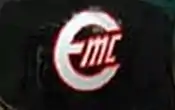EMC Motorcycles
EMC Motorcycles or the Ehrlich Motor Co was a British motorcycle manufacturer. Based in Isleworth, the business was founded by Joseph Ehrlich who emigrated to the United Kingdom from Austria in the 1930s.[1]
 | |
| Industry | Manufacturing and engineering |
|---|---|
| Founded | 1946 |
| Defunct | 1977 |
| Fate | Wound up |
| Headquarters | Isleworth, UK |
Key people | Dr Joseph Ehrlich |
| Products | Motorcycles |
A specialist engine tuner, Joe Ehrlich made unique two-stroke motorcycles. EMC stopped mass production in 1952 but Ehrlich used his knowledge of German technology to re-engineer the DKW Rennsporte Ladempumpe production racers, which he developed as one-off EMC racing bikes and won several events over the next 25 years.[2] The EMC 125 cc racer was considered among the fastest of its size in the early 1960s. Ehrlich left in 1967 and the company was wound up in 1977.[1]
History
Dr Joseph Ehrlich was a wealthy Austrian and keen motorcycle enthusiast who became the acknowledged authority on two-stroke single racing bikes. Ehrlich moved to the UK and set up EMC after the Second World War with a factory at Isleworth. Production focused on a 350 cc split-single motorcycle based on German engineering using two cylinders and pistons with a common combustion chamber. One cylinder housed the exhaust ports and the other the transfer ports. EMC also imported Puch 125 cc split-single, four-speed engines from Austria as there was nothing to compete in the UK market at the time.[2]

Dr Ehrlich worked throughout his life to improve engine performance. In 1948 he built a three-cylinder motorcycle engine that was banned from racing circuits as "too powerful".[3] EMC racing motorcycles (and cars) were used by some of the leading riders, including Mike Hailwood who rode an EMC to fifth place in the 1962 125 cc world championship and won the 1962 Saar Grand Prix.[4][5] From 1981, 250 cc EMC motorcycles won 4 Junior TTs at the Isle of Man and an EMC was the first 250 cc motorcycle to break the 110 miles per hour (180 km/h) lap record.[6] Ehrlich went on to develop Formula 3 racing cars and although he retired from EMC in 1967 his interest in racing motorcycles continued and he produced one-off 250 cc Rotax-engined bikes in the 1980s and his last competitive motorcycle in 1995 – when he was in his 80s.[7][8]
Ehrlich's experience with early two-stroke designs led to work on the 'Environmental Engine' that had variable compression and variable capacity to improve emission and fuel consumption. Potentially the future of engine technology, Josef Ehrlich died in September 2003 aged 89 without seeing his engine designs developed commercially.[3]
Models
| Model | Year | Notes |
|---|---|---|
| EMC 350 cc | 1948 | Split single cylinder |
| EMC Model T | 1953 | Jap engine |
| EMC 125 cc | 1963 | Water-cooled twin |
References
- "EMC Motorcycles". Retrieved 5 July 2008.
- Hogan, Peter (30 November 2002). "Racing Split Single Two Stroke Motorcycles in Post War England". Archived from the original on 16 June 2008. Retrieved 5 July 2008.
- "History of EE technology". Archived from the original on 18 July 2008. Retrieved 5 July 2008.
- "1962 125cc world championship standings". motogp.com. Retrieved 15 June 2011.
- "Works EMC bikes on the auction block". Retrieved 5 July 2008.
- "TT Race analysis". Retrieved 5 July 2008.
- "Ehrlich EMC". Retrieved 5 July 2008.
- Brown, Roland (2002). Classic Motorcycles. Anness Publishing. p. 137. ISBN 1-84038-433-6.